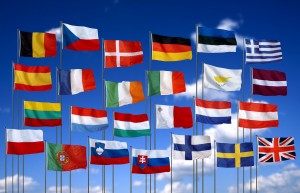Update April 2014: The EU voted to raise the target to 30% renewable energy and to improve efficiency by 40% by 2030.
—-
At the last UN Climate Summit, participating countries agreed to arrive at the 2015 treaty meeting with concrete climate targets
in hand that would be implemented no later than 2020. To
get the ball rolling, the European Commission announced its
goals last week.
The EU set a new binding target to reduce greenhouse gas (GHG) emissions 40% (below 1990 levels) by 2030 while getting 27% of its energy from renewable energy by then (which can include nuclear energy). A target for energy efficiency is still under review. The plan costs an estimated $52 billion a year.
Since the Kyoto Protocol was first developed, the EU has led the
world on both counts – cutting GHG emissions and ramping up renewable energy, mostly solar and wind. In 2010, it adopted a much stronger 20/20/20 plan: cut GHG emissions 20%, raise renewable energy to 20% and increase energy efficiency 20% by 2020. Each country has binding goals in accordance with its circumstances.

The EU is on track for two of three targets – surprisingly, energy efficiency is the laggard. GHG emissions are down 18% from 1990 levels, during a time when economic output has grown 45%,says Jose Manuel Barroso, President of the European Commission.
Across the EU, renewable energy produces 12.7% of all energy consumption – electricity, heating and transportation – and countries like Germany and Spain exceed 20%. In contrast, the figure for the US is about 9.5%.
Disappointment Abounds
While many are disappointed by the new targets, saying they could – and need to – go much further, no other country – much less a union of 28 countries – has gone this far. President Obama, for example, says the US will cut emissions 17% by 2020 from 2005 levels – not 1990 levels. And that hasn’t even been ratified by Congress.
There’s widespread disappointment with the 27% target for renewable energy. While Barroso says this will give investors the certainty they need, it is being roundly criticized by NGOs and the renewable energy industry.
The European Environmental Bureau, the region’s largest federation of environmental citizen organizations, is calling for a minimum 60% target for cutting GHG emissions and 45% for renewable energy, reports Bloomberg.
"While the binding 2020 target for renewables proved to be a success story, initiating massive cost reductions and technology leadership in Europe, the Commission’s proposal for 2030 sadly is a lame duck," says Frauke Thies, Policy Director for the European Photovoltaic Industry Association. "27% renewables by 2030 is indeed barely more than the Commission’s business-as-usual scenario. In addition, it is an EU-wide target without binding national breakdowns. We are now looking at the European Council to make
this supposedly binding target meaningful, by turning it into real national binding targets."
The European Wind Energy Association calls the GHG proposal "weak" and the renewables goal, a "non-target."
Critics say that years of deep recession have taken a toll on Europe’s visionary and world leading commitments. Government leaders are giving in to pressure from industry and citizens to keep costs down.
While we constantly hear that countries are pulling back on renewable energy subsidies (feed-in tariffs) because of skyrocketing electricity prices, there’s another side to the story:
“The Commissioner’s analysis clearly shows that renewables help reduce wholesale electricity prices. But while large energy consumers are directly benefiting from this effect, those benefits currently aren’t passed onto the final consumers,” says Thies. “Meanwhile, invisible to consumers are the many tax exemptions and subsidies that go to fossil fuels and nuclear.”
Essentially, the formula is a compromise between countries like the UK and Germany, which have created a strong base for further progress, and countries like Poland, which still rely mostly on fossil fuels.
Germany and the UK want binding targets for each member state. Europe would never have made as much progress as it has without binding targets, Sigmar Gabriel, Germany’s Economy and Energy Minister, told Associated Press.
The fear is that if the EU pulls back on aggressive targets that lets countries like the US and China off the hook.
“Britain has been clear that Europe must be ready to adopt a 50% target if the rest of the world is prepared to sign an ambitious global climate deal in 2015,” Edward Davey, Secretary of Energy and Climate Change, told AP.
Business interests see it differently, however, saying the EU has for too long taken the leadership position without followers, making it hard to compete because of high energy prices.
Fracking Allowed
Another extremely controversial element of the plan is the opening of the EU to natural gas fracking for the first time.
Under the plan, the EU would set minimum standards for fracking related to environmental safety and human health and each state will be assessed and scored on how they are complying.
The plan still needs to be approved by member states and the European Parliament this year.
"The direction for Europe has been set," says Connie Hedegaard, European Commissioner for Climate Action. "If all other regions were equally ambitious about tackling climate change, the world would be in significantly better shape.”
The real problem is that NO country has set targets consistent with scientific data on reductions that are necessary to keep warming from exceeding the 2°C threshold. Planet Earth is currently hurtling toward the very worst scientific projections of global temperature rise on the order of 10°F.
